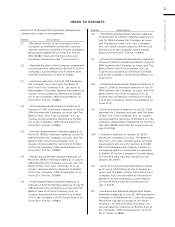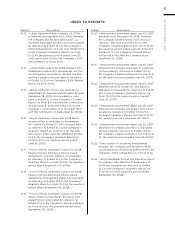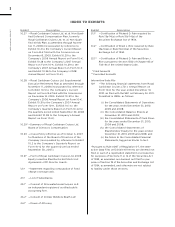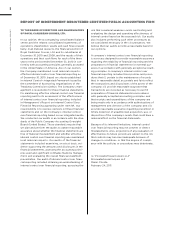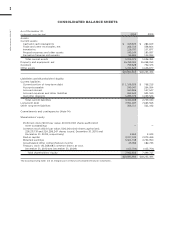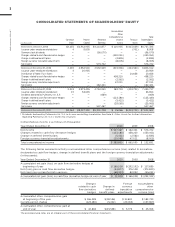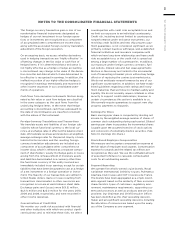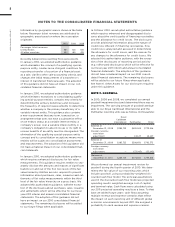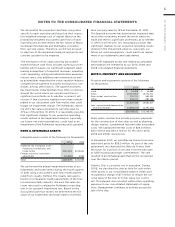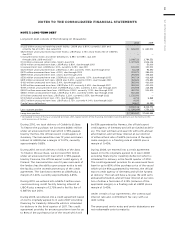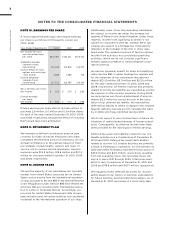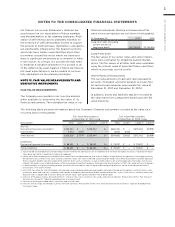Royal Caribbean Cruise Lines 2010 Annual Report Download - page 70
Download and view the complete annual report
Please find page 70 of the 2010 Royal Caribbean Cruise Lines annual report below. You can navigate through the pages in the report by either clicking on the pages listed below, or by using the keyword search tool below to find specific information within the annual report.
NOTES TO THE CONSOLIDATED FINANCIAL STATEMENTS
ROYAL CARIBBEAN CRUISES LTD. 67
NOTE 1. GENERAL
Description of Business
We are a global cruise company. We own five cruise
brands, Royal Caribbean International, Celebrity
Cruises, Pullmantur, Azamara Club Cruises, and CDF
Croisières de France with a combined total of 40 ships
in operation at December 31, 2010. Our ships operate
on a selection of worldwide itineraries that call on
approximately 420 destinations. We also have a 50%
investment in a joint venture which operates the brand
TUI Cruises with TUI AG, a German-based multinational
travel and tourism company.
Basis for Preparation of Consolidated
Financial Statements
The consolidated financial statements are prepared
in accordance with accounting principles generally
accepted in the United States of America. Estimates
are required for the preparation of financial statements
in accordance with these principles. Actual results
could differ from these estimates. All significant inter-
company accounts and transactions are eliminated in
consolidation. We consolidate the operating results
of Pullmantur and its wholly-owned subsidiary, CDF
Croisières de France, on a two-month lag to allow for
more timely preparation of our consolidated financial
statements. No material events or transactions affect-
ing Pullmantur and its wholly-owned subsidiary, CDF
Croisières de France, have occurred during the two-
month lag that would require disclosure or adjust-
ment to our consolidated financial statements as of
December 31, 2010, except for the sale of Bleu de
France, as described in Note 5. Property and Equipment.
We consolidate entities over which we have control,
usually evidenced by a direct ownership interest of
greater than 50% and variable interest entities where
we are determined to be the primary beneficiary. See
Note 6. Other Assets for further information regarding
our variable interest entities. For affiliates where sig-
nificant influence over financial and operating policies
exists, usually evidenced by a direct ownership inter-
est from 20% to 50%, the investment is accounted for
using the equity method.
NOTE 2. SUMMARY OF SIGNIFICANT
ACCOUNTING POLICIES
Revenues and Expenses
Deposits received on sales of passenger cruises are
initially recorded as customer deposit liabilities on our
balance sheet. Customer deposits are subsequently
recognized as passenger ticket revenues, together
with revenues from onboard and other goods and
services and all associated direct costs of a voyage,
upon completion of voyages with durations of ten
days or less, and on a pro rata basis for voyages in
excess of ten days. Revenues and expenses include
taxes assessed by governmental authorities that are
directly imposed on a revenue-producing transaction
between a seller and a customer. The amounts included
in passenger ticket revenues on a gross basis were
$398.0 million, $303.2 million and $213.4 million for
the years 2010, 2009 and 2008, respectively.
Cash and Cash Equivalents
Cash and cash equivalents include cash and market-
able securities with original maturities of less than
90 days.
Inventories
Inventories consist of provisions, supplies and fuel
carried at the lower of cost (weighted-average)
or market.
Property and Equipment
Property and equipment are stated at cost less accu-
mulated depreciation and amortization. We capitalize
interest as part of the cost of acquiring certain assets.
Improvement costs that we believe add value to our
ships are capitalized as additions to the ship and
depreciated over the improvements’ estimated useful
lives. The estimated cost and accumulated deprecia-
tion of replaced or refurbished ship components are
written off and any resulting losses are recognized
in cruise operating expenses. Liquidated damages
received from shipyards as a result of the late delivery
of a new ship are recorded as reductions to the cost
basis of the ship.
Depreciation of property and equipment is computed
using the straight-line method over estimated useful
lives of primarily 30 years for ships, net of a 15% pro-
jected residual value, and three to 40 years for other
property and equipment. Depreciation for assets under
capital leases and leasehold improvements is com-
puted using the shorter of the lease term or related
asset life. (See Note 5. Property and Equipment.)
We review long-lived assets for impairment whenever
events or changes in circumstances indicate, based
on estimated undiscounted future cash flows, that
the carrying amount of these assets may not be fully
recoverable.
We use the deferral method to account for drydocking
costs. Under the deferral method, drydocking costs
incurred are deferred and charged to expense on a
straight-line basis over the period to the next scheduled
drydock which we estimate to be a period of thirty to
sixty months based on the vessel’s age as required by
class. Deferred drydock costs consist of the costs to
drydock the vessel and other costs incurred in con-
nection with the drydock which are necessary to
maintain the vessel’s Class certification. Class certifi-
cation is necessary in order for our cruise ships to be
flagged in a specific country, obtain liability insurance
and legally operate as passenger cruise ships. The


